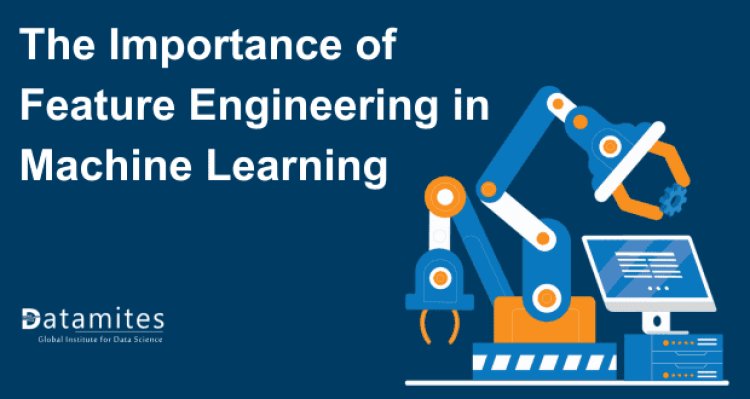The Importance of Feature Engineering in Machine Learning
Feature engineering is a crucial step in machine learning, as it helps transform raw data into meaningful features that improve model performance. Proper feature selection and transformation can significantly boost accuracy and reduce overfitting.

In the world of machine learning, the term “feature engineering” might seem like a complex concept reserved for data scientists and AI experts. However, it is a crucial process that significantly impacts the performance and accuracy of machine learning models. Feature engineering involves creating, modifying, and selecting features from raw data to improve the effectiveness of predictive algorithms.
Understanding feature engineering is essential for anyone embarking on a career in artificial intelligence (AI) or taking an artificial intelligence course. It is not just about manipulating data but about enhancing the ability of models to make accurate predictions. This blog post aims to demystify feature engineering and highlight its importance in the machine learning process.
What is Feature Engineering?
Feature engineering is the process of taking raw data and turning it into useful inputs, called features, that a machine learning model can use to learn and make predictions. Good feature engineering involves extracting useful information from the data and presenting it in a form that improves model performance.
Role in Machine Learning
In the machine learning pipeline, feature engineering comes after data collection and preprocessing but before model training. Here's how it fits into the whole process:
- Data Collection: Collecting basic information from different places.
- Preprocessing: Cleaning and organizing data for analysis.
- Feature Engineering: Making and choosing the most important features.
- Model Training: Using engineered features to train and validate machine learning models.
- Evaluation: Assessing model performance and iterating if necessary.
Read these articles:
- Introduction to Neural Networks: Building Blocks of AI
- Introduction to Artificial Intelligence - Key Concepts and Applications
- Artificial Intelligence vs Machine Learning
The Importance of Feature Engineering
Feature engineering is a key part of machine learning where we turn raw data into useful information that helps our model perform better. Here’s why it’s so important:
Impact on Model Performance
Well-engineered features can dramatically enhance the performance of machine learning models. By providing models with the right information, feature engineering helps in:
- Improving Accuracy: Better features lead to more accurate predictions.
- Increasing Predictive Power: Models can learn more from meaningful features.
Data Quality Enhancement
Feature engineering also plays a crucial role in improving data quality. Techniques in this area help to:
- Clean Data: Remove noise and irrelevant information.
- Transform Data: Turn raw data into something easier to use.
Reducing Overfitting
Overfitting occurs when a model learns the training data too well, including its noise and errors, which impairs its performance on new data. Feature engineering helps to:
- Select Relevant Features: Use only the most pertinent information.
- Reduce Complexity: Simplify models to prevent overfitting.
Dimensionality Reduction
High-dimensional data can make models more complicated and harder to understand. Feature engineering techniques such as:
- Feature Selection: Choose the most important features.
- Dimensionality Reduction: Use methods like PCA to reduce the number of features.
Types of Feature Engineering
Feature engineering is important for making machine learning models work better by creating or changing features to more accurately reflect the data. The main types of feature engineering include:
- Feature Extraction: This means making new features from basic data. For example, extracting date parts (year, month, day) from a timestamp or generating text-based features like sentiment scores from text data.
- Feature Selection: This process involves choosing the most relevant features from a set of candidate features. Methods include statistical tests, correlation analysis, and feature importance from models like Random Forest.
- Feature Transformation: This refers to modifying existing features to improve model performance. Common techniques include normalization (scaling features to a standard range), encoding categorical variables (e.g., one-hot encoding), and applying mathematical functions (e.g., logarithms or polynomials).
- Feature Creation: Creating new features based on domain knowledge or interactions between existing features. For example, you can combine "height" and "weight" to create a "BMI" measurement.
- Dimensionality Reduction: Techniques like Principal Component Analysis (PCA) or t-Distributed Stochastic Neighbor Embedding (t-SNE) reduce the number of features while retaining essential information, often used to simplify models and visualize high-dimensional data.
These methods help in crafting features that better capture the patterns in the data, leading to more effective machine learning models.
Refer these articles:
- What Is AI Engineer Course?
- What is Certified Data Scientist Course?
- What is Datamites Certified Data Analyst course
Key Techniques in Feature Engineering
Feature engineering is a key step in building machine learning models. It means getting the data ready and fixing it up so the models can work better. It involves creating, transforming, and selecting features (or variables) to improve the performance of a model. Here are some key techniques:
Handling Missing Values
Dealing with missing values is crucial. Techniques include:
- Imputation: Use mean, median, or mode to fill in missing data.
- Ignoring: Exclude data points with missing values when necessary.
Encoding Categorical Variables
Converting categorical variables into numerical data involves:
- One-Hot Encoding: Make a separate column for each category using binary values (0 or 1).
- Label Encoding: Assign numerical values to categories.
- Target Encoding: Use target variable statistics for encoding.
Scaling and Normalization
Scaling and normalizing data helps ensure that features contribute equally. Techniques include:
- Standardization: Adjust the data so that it averages out to zero and each value is spread out with a standard deviation of one.
- Min-Max Scaling: Scale features to a fixed range, typically 0 to 1.
Binning and Discretization
Binning involves converting continuous features into discrete categories. This can:
- Simplify Models: Reduce the complexity of data.
- Improve Interpretability: Make data more understandable.
Feature Interaction
Creating new features by combining existing ones can provide additional insights:
- Polynomial Features: Generate interactions of existing features.
- Cross-Features: Combine features to capture interactions.
Date and Time Feature Extraction
Extracting features from dates and times can provide valuable insights:
- Extract Components: Year, month, day, etc.
- Time-Based Features: The hour of the day and the day of the week.
Domain-Specific Feature Creation
Incorporating domain knowledge into feature creation enhances model relevance:
- Industry Knowledge: Use expert insights to generate meaningful features.
- Custom Features: Develop features tailored to specific problems.
Case Studies and Industry Applications of Feature Engineering
Feature engineering plays a crucial role in enhancing model performance across various industries. Here are some detailed examples illustrating its impact:
Industry Applications
Finance: Predicting Stock Prices
- Creating Financial Indicators: Engineers developed features like moving averages, volatility measures, and trading volume indicators.
- Sentiment Analysis: Extracted sentiment from news articles and social media to predict market movements.
- Outcome: These engineered features helped in improving predictive models, leading to better forecasting accuracy for stock prices and investment decisions.
Healthcare: Enhancing Patient Outcome Predictions
- Chronic Condition Indicators: Created features indicating the presence and severity of chronic conditions such as diabetes or heart disease.
- Temporal Features: Added time-based features to track changes in health metrics over time.
- Outcome: This approach improved the precision of patient readmission predictions and allowed for more personalized treatment plans, ultimately enhancing patient care and resource allocation.
Example of Poor Feature Engineering: Retail Sales Forecasting
Issues Encountered:
- Lack of Relevant Features: The model failed to incorporate crucial features like seasonal trends and promotional events.
- Improper Data Handling: Missed data and anomalies were not addressed, leading to incomplete and inaccurate inputs.
- Outcome: The shortcomings in feature engineering led to inaccurate sales predictions and poor business decisions, highlighting the importance of thorough and thoughtful feature design.
These examples underscore the transformative impact that effective feature engineering can have on model performance and decision-making across various fields.
Tools and Libraries for Feature Engineering
Feature engineering is a crucial step in building effective machine learning models, and there are several tools and libraries available to help with this process. The following are a handful of the most well-known:
Python Libraries
- pandas: It provides strong tools for working with and analyzing data, like data frames, which are key for cleaning and changing data.
- scikit-learn: Provides various utilities for feature selection, extraction, and transformation, including techniques like scaling and encoding.
- Featuretools: Focuses on automated feature engineering by creating new features from existing data using deep feature synthesis.
R Libraries
- caret: Simplifies the process of creating predictive models and includes tools for feature selection and pre-processing.
- dplyr: Offers a set of functions for data manipulation that make it easier to prepare data for analysis.
- data.table: Offers quick and effective ways to handle data, great for big datasets and complex tasks.
Automated Feature Engineering Tools
Featuretools: As mentioned, it automates feature engineering by generating new features through various transformations and aggregations.
tsfresh: Specializes in extracting meaningful features from time series data, which is useful for time-dependent predictions.
These tools and libraries can help streamline the feature engineering process, enhance model performance, and ultimately lead to better insights from your data.
Refer these articles:
- Artificial Intelligence Course Fee in India
- Artificial Intelligence Course Fee in Hyderabad
- Artificial Intelligence Course Fee in Chennai
Best Practices in Feature Engineering
Feature engineering is an important step in creating good machine learning models. It involves choosing and preparing the right information for the model to learn from. Here’s a deeper dive into the best practices:
Iterative Process
Continuous Refinement: Regularly review and improve features based on feedback from how well the model performs. This could mean adjusting or adding new features as you gather more insights or as the data evolves.
Experimentation:
- Feature Creation: Experiment with creating new features through combinations, transformations, or domain-specific insights.
- Feature Selection: Try different methods for selecting features, like statistical tests or model-based approaches (e.g., feature importance from tree-based models).
Cross-Validation and Testing
Use Cross-Validation:
- K-Fold Cross-Validation: Split the data into K parts and train the model K times. Each time, use one part as the test set and the other K-1 parts as the training set. This helps in assessing the model’s performance across different data splits.
Evaluate Performance:
- Compare Feature Sets: Use metrics like accuracy, precision, recall, F1 score, or area under the ROC curve (AUC) to compare the effectiveness of different feature sets.
- A/B Testing: In some cases, especially in production environments, you can deploy different feature sets to a subset of users to compare real-world performance.
Documentation and Reproducibility
Track Changes:
- Version Control: Use version control systems like Git to track changes in feature engineering code and decisions.
- Change Logs: Maintain logs detailing changes in feature sets, transformations applied, and rationale behind them.
Reproduce Results:
- Scripts and Notebooks: Use scripts or Jupyter notebooks to document the feature engineering process in a way that can be easily executed and reviewed.
- Environment Management: Use tools like Docker or Conda to ensure that the environment in which features are engineered can be replicated.
Additional Best Practices
- Domain Knowledge: Incorporate domain-specific knowledge to engineer features that are meaningful and relevant to the problem at hand.
- Feature Scaling: Apply scaling techniques (like normalization or standardization) when needed, especially for algorithms sensitive to feature magnitudes.
- Feature Interaction: Explore interactions between features, as sometimes combining features can reveal more insights than individual features.
Feature engineering is about understanding your data deeply and continuously improving your approach to extract the most valuable information. By following these best practices, you can create features that significantly enhance your model’s performance.
Feature engineering is a cornerstone of machine learning that significantly impacts model performance. Mastering this process is crucial for anyone involved in AI or undergoing artificial intelligence training. As the field evolves, staying updated on best practices and tools will ensure continued success in building effective models.
DataMites Institute stands out with its top-tier courses in Artificial Intelligence and Machine Learning, both accredited by IABAC and NASSCOM FutureSkills. With over 100,000 learners benefiting from their expertise, DataMites has over a decade of experience in the field. In addition to AI and ML, their offerings include Data Science, Data Analytics, and Python Programming courses. Students gain hands-on experience through real-time internships, unlimited projects, and access to an exclusive practice lab. This blend of practical experience and high-quality education ensures that learners are well-prepared for the dynamic tech industry.
DataMites Training Institute offers a thorough Artificial Intelligence course, accredited by global certifications for industry recognition. The program includes machine learning, deep learning, and AI tools, featuring hands-on projects and expert guidance. With flexible learning options, such as online and classroom formats, it caters to both beginners and professionals. Backed by internationally recognized certification, DataMites equips learners for successful AI-driven career paths.





